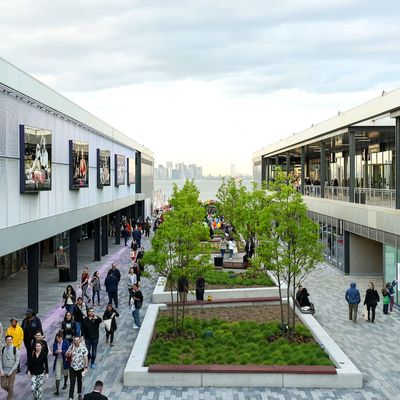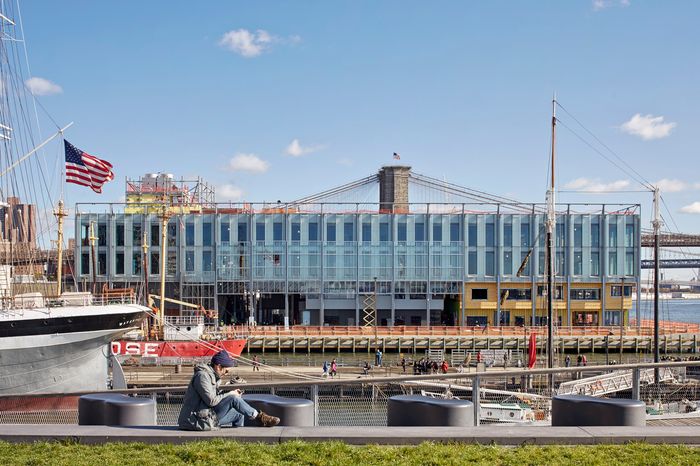
In the opening paragraphs of Moby-Dick, Melville describes the strange tug of the waterfront, the crowds of working men and women who, sprung from their shops and desks on a weekend afternoon, drift from Manhattan’s upland blocks down to the piers and quays. The water’s magnetic draw persists even more powerfully today, now that sugar refineries, sawmills, chemical plants, and shipbuilders have mostly given up their claim to the urban shoreline. The mere sight of waves supercharges otherwise ordinary forms of leisure: dining, drinking, jogging, reading — and shopping. You wouldn’t think that proximity to water would make much difference to the experience of buying a T-shirt, but it does.
Brine is the secret ingredient in New York’s newest shopping destination, Empire Outlets, a discount mall on the north shore of Staten Island that is opening in stages, with a July 4 party and Nordstrom Rack up next. Its chief appeal is the location, a vineyard-like set of terraces stepping up from the Staten Island Ferry terminal and beckoning to the courthouse and law offices up the hill. From its landscaped plazas lifted above the flood zone, with pop-up seating and tall grasses waving from planters, you can watch the occasional freighter slip by, its deck piled high with shipping containers. Entire fleets dedicated to postindustrial leisure and transportation bob into the slice of water framed by the stores: ferries, water taxis, jet skis, sailboats, tour boats, and the occasional yacht.
It may seem suicidal to build a big new mall at a time when retail is floundering, once lively New York avenues look like a depression has passed through, and even bold new bets on “experience” shopping haven’t paid off. But outlet malls are cheaper and more resilient, especially in a metropolitan area where they can surf rising tides of tourism. For many foreign visitors, the whole country is a giant discount mall. Outlet centers offer such thrilling bargains that millions of tourists budget a full day for Woodbury Common, including the three-hour round trip by bus from Manhattan. Empire Outlets hopes to skim off some less single-minded shoppers, who are happy to idle away an hour at the Gap after a refreshing ride through New York Harbor. More than 3 million visitors a year take the Staten Island Ferry; until a few weeks ago, they virtually all filed off the boat, lingered for roughly 45 seconds, and boarded again for the return trip. Now they have a reason to stay, somewhere to go, and something to buy. Soon, they’ll have plenty to eat and drink. When a giant rooftop beer garden opens next spring, it should be a godsend to Staten Islanders in need of a happy hour to break up their commute. Though it sits atop a large underground parking garage, this is the rare outlet center that is easily reachable by sea, bus, subway, and on foot.
Making the most of these favorable winds fell to SHoP Architects, a firm that has already left deep marks on the waterfront. They designed the East River Esplanade south of the Brooklyn Bridge; the double-decker Pier 15, with its aerial lawns and scarlet undersides; and the glass-block monolith of Pier 17. On Staten Island, the firm has matched the outlet aesthetic with good-value design — durable and moderately stylish, with an occasional touch of flair (escalators sheathed in orange glass). A row of glass-sided, metal-trimmed boxes face the harbor, leaning slightly forward like a bank of television screens. These side-by-side indoor viewing decks seem oddly foreign in a shopping mall, where retailers, like casino operators, usually block out any reminder of the outside world. The designers of the U.S. Polo Assn. store have controlled the impulse to cover the floor-to-ceiling window with Sheetrock, and blocked it with shelving instead. A wedge of harbor is visible over the cashier’s shoulder, but by that time the customer is ready to pay.
The mall’s site plan would resonate with Melville. “Right and left, the streets take you waterward” — three angled promenades, to be precise, crisscrossed by a boulevard and wider courts. In plan it could almost be a fishing village, except that the place of the church is taken by American Eagle. The sober color scheme — dark glass, steel railings, concrete bleachers, aluminum mesh, and pavers in shades of grey — doesn’t get in the way of all the gaudy branding or festive touches like the brightly colored outdoor chairs that pop open like giant tulips. With quiet sleight of hand, the architects have managed to reconcile a collection of generic, inward-facing stores with a never-ending street party.
Across the harbor, at the South Street Seaport, SHoP again fuses indoors and out, though to clunkier effect. From a distance, Pier 17 looks like an office tower taking a nap, its fat glass bulk jabbing toward Brooklyn. Get in close and the ground-floor liveliness starts to emerge: pathways that lead from the open-air deck through the building’s mass, an appealing mix of textures (glass fins, wooden slats, I-beams studded with rivets), assorted seating options, and a couple of quirky bar kiosks facing the Brooklyn Bridge. Jean-Georges Vongerichten’s new seafood restaurant, the Fulton, offers such glamorous close-ups of the East River that they give the oysters an extra shot of intensity.
On a summer evening at sunset, Pier 17 feels less like a building than a podium for the roof, which was originally planned as an elevated park but instead functions as a rooftop bar and outdoor concert venue. From this crow’s nest, with its wraparound panorama of towers, bridges, and water, you can see the natural endpoint of the postindustrial waterfront. Once the lifeblood of the city’s mercantile economy, then an oily no-man’s land and an emerging strip of parkland, the best shoreline spots are being repurposed as spots in which to sell alcohol, food, music, and gear. In late capitalist New York, the waterfront must be monetized.































